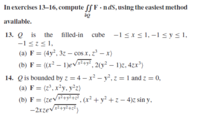I've been given this question, and I'm just feeling very stuck. I've tried different things and haven't really gotten anywhere yet. If there is anybody who is able to help me get started, I would really appreciate that.
I realize I am not posting my steps - it is because I haven't gotten anywhere even after much time spent on the problem. However, I need to know how to solve the problem, so I'm trying to learn how. I'm not just looking for an answer, I'm trying to understand the process so I can do it myself.
Compute \(\iint_{\partial Q}F\bullet n\ dS\) using the easiest method available. \(Q\) is bounded by \(z=4-x^2-y^2,\ z=1\), and \(z=0\). \(F=<ze^{\sqrt{x^2+y^2+z^2}},(x^2+y^2+z-4)z\sin(y),-2xze^{\sqrt{x^2+y^2+z^2}}>\)
Any help is appreciated. I do see a pattern - the value given for z has the value given for x in it. In general, the terms do seem to be related, etc. But, I have no clue about what to do with this pattern.
I realize I am not posting my steps - it is because I haven't gotten anywhere even after much time spent on the problem. However, I need to know how to solve the problem, so I'm trying to learn how. I'm not just looking for an answer, I'm trying to understand the process so I can do it myself.
Compute \(\iint_{\partial Q}F\bullet n\ dS\) using the easiest method available. \(Q\) is bounded by \(z=4-x^2-y^2,\ z=1\), and \(z=0\). \(F=<ze^{\sqrt{x^2+y^2+z^2}},(x^2+y^2+z-4)z\sin(y),-2xze^{\sqrt{x^2+y^2+z^2}}>\)
Any help is appreciated. I do see a pattern - the value given for z has the value given for x in it. In general, the terms do seem to be related, etc. But, I have no clue about what to do with this pattern.

